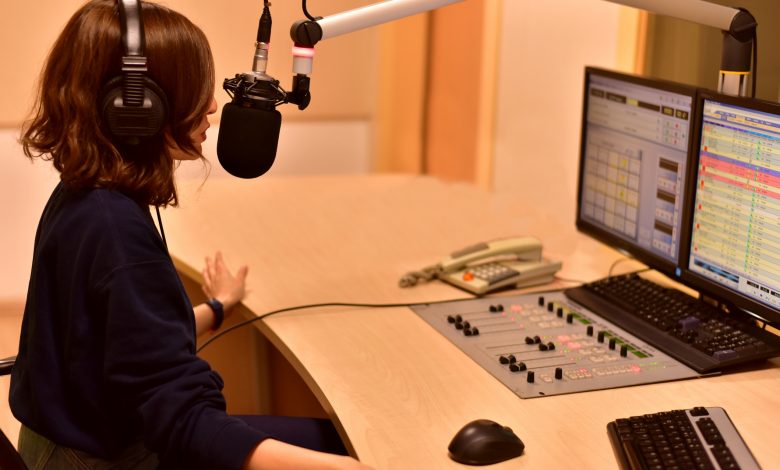7 Tips for Recording and Launching a Successful Podcast



I’ll walk you through the steps to make sure your video podcast gets off to a great start in this post. From design to technological setup, promotion, and monetization, we’ll cover it all. While each podcast is unique, this guide should assist you in navigating the process and, hopefully, inspire you to start your own.
-
Pick a subject that you’re enthusiastic about.
It’s a good idea to think about why you’re starting this podcast in the first place before you hit record. And don’t skimp on this move! It takes a lot of effort to start a podcast (maybe more than you think). Not everybody is suited to it. However, we’ll say you are.
Finding a subject on which you can naturally and constantly converse is a good place to start. Your true calling in life. We’ve all got one. How about you, what’s yours? A successful test is to perform a show without any notes or planning. Can you talk about your subject off the top of your head for 30 to 60 minutes and keep it interesting? That’s great! You’ve discovered your subject.
Now go to iTunes and look for other podcasts in your field. Did you choose a crowded niche with a lot of other podcasts? Consider how you can set your show apart from theirs. You may, for example, choose a sub-niche with a more focused audience.
-
Build a Podcast Brand
It’s time to start creating your podcast now that you’ve decided on a subject. Your podcast, like any other product or service, has its own identity. Choosing a good name for your podcast is the first step in branding it.
Choose something unforgettable and relevant to your topic/audience. Direct, descriptive names, in my view, work better than abstract or overly imaginative names. You’ll need your audience to turn in before you can catch them with your killer smile and ground-breaking material. That’s why the podcast’s title needs to stand out and catch their attention. Remember that a large portion of your audience can find your podcast via iTunes or a Google search. As a result, it’s a good idea to include a keyword or two in the title of your show.
After that, you’ll need a logo. It’s crucial to create an eye-catching logo and a display picture for your iTunes listing if you’re doing a podcast. It’s all about building your brand to stand out in the iTunes podcast search results once again.
-
Structure and Format
Is this going to be a visual or audio podcast? Video podcasts, in my opinion, have a better chance of gaining popularity with an audience simply because they are more personal. You’re selling your personality as well as valuable material, and video is the most powerful and authentic way to do so. Offering an audio-only version of the podcast for those who choose to listen rather than download large video files is a smart idea.
We must now organize the presentation. Let’s begin with your timetable. Once a week, maybe? Once a month, perhaps? Be sure to stick to your timetable, no matter what it is. Release a show four weeks in a row and then go on hiatus for several months is a fast way to lose viewers. A daily schedule, and even a regular day of the week, is appreciated by most people.
Finally, you must decide on the duration of your presentation. Divide it into sections and give each one a specific period of time. I think 30 to 50 minutes is a decent length for an episode because it’s long enough to have a good, in-depth conversation while still being short enough to fit into a daily work commute. Some people prefer short episodes of less than 20 minutes. Consistency is crucial once again. You don’t want to set the bar for 45-minute episodes only to deliver a 15-minute episode.
-
Make a Content Strategy
It’s now time to plan out the most crucial part of your podcast: the material. The adage “content is king” applies to podcasts as well. The success of your podcast will ultimately be determined by the subjects, discussion flow, personality, and overall engagement.
Keeping a running list of show topics is a smart idea. As soon as an idea comes to you, jot it down and schedule it for a future broadcast. One of the ways my co-host Dave and I come up with show ideas is to clearly recognize when we come across a great one. We’ll be having a casual conversation about freelancing and web design when it unexpectedly occurs to us that we’ve stumbled on something important and interesting for the show. Make a note of it.
Some podcasts divide each episode into pieces. If your niche has something to do with current affairs, it may be a good idea to include news segments in your program. Perhaps a guest interview is an important part of your plan. Make a plan for each of these segments, keeping in mind their timing and flow.
Finally, it’s a good idea to consider writing a script for your show. This will be unique to each person. My preference is to have a few sentences prepared ahead of time to use as the show’s introduction; anything to get things off to a good start and properly introduce the subject and guest. The show’s remaining topics are organized using brief bullet lists that indicate which points I want to cover.
The goal is to ensure that I cover anything I want to cover while maintaining a natural and improvised delivery. It’s up to you to strike the right balance once more.
-
Make a podcast, broadcast it, and edit it.
Now, let’s talk about some of the technical aspects of making a video podcast. Surprisingly, putting together a working podcast needs quite a few resources. The ones we use are as follows:
Blue Yeti USB Condensor Microphone — Investing in a good microphone is important. It will significantly boost the show’s audio quality. The Yeti USB microphone is inexpensive and produces excellent sound.
Skype — All of our shows begin with a video chat on Skype. With the addition of video conference calls in Skype 5, it’s an excellent option for a three-way conversation. Furthermore, the widespread use of Skype makes it simple for our guests who are already familiar with the forum for online communication.
BoinxTV — BoinxTV acts as our virtual control room, enabling us to broadcast our show live over the internet. It includes features such as fast switching between cameras and displays, as well as visual effects such as captions and transitions.
When you want to broadcast live on the internet, Justin.tv or UStream are both viable alternatives. To start the live show, we feed our BoinxTV performance into one of these services. The video and chat room are then embedded directly on our website, allowing the audience to engage in real-time.
CamTwist — With this small program, we can route the video feed between BoinxTV and Justin. tv or UStream.
Audio Hijack Pro — This entertaining little app is used to route Skype audio into BoinxTV. Check out the trance sound effects you can use while you’re at it!
Skype Call Recorder — This Skype plugin provides the ability to record a Skype call. If you just want to make a recorded podcast, this is a good option (not broadcasting live). It also includes tools for separating a dialogue into individual movie files and extracting an MP3 audio file from your movie file.
-
Expand Your Target Market
Now that your podcast has been produced and released to the public, the hard part begins: promoting it and growing your audience.
I believe that if you concentrate your energies on making the most compelling and engaging content possible, you can attract an audience and build a community around your work. Visit techmong for more podcasting tips and guides.
Read More: one-piece filler list


